CONTENTS:
Maui
The Fish Hook
Maui’s Animal Forms
LINKS:
Moana – A Parable of Christ – Part 1
Moana – A Parable of Christ – Part 2
Moana – A Parable of Christ – Part 3
Moana – A Parable of Christ – Part 4
Moana – A Parable of Christ – Part 5
Moana – A Parable of Christ – Part 6
Moana – A Parable of Christ – Part 7
Moana – A Parable of Christ – Part 8
WARNING: If you have not seen the movie yet, the remainder of this post is full of spoilers. I had to assume that readers had already seen the movie in order to write it.
MAUI
I have watched some of the behind-the-scenes video put out by Disney in regard to this character. They discuss the way he was to be depicted in animation: bald or with more mana (power) having hair. It was good that they went with the hair, because otherwise the character would have very closely resembled the trolls or orcs in the Harry Potter or Lord of the Ring movies. (You can’t please everybody, though, since I guess there is an uproar now from some Polynesians about Maui being “stereotypically obese” and therefore Disney is fat-shaming all Polynesians on the Standard American Diet?) They also discuss who their first choice for Maui’s voice-actor was, a man named Dwayne “The Rock” Johnson. Maybe I don’t watch the movies that everybody else watches, because I don’t know who this guy is. Apparently, everybody says Dwayne is disarmingly charming and loved by all. Supposedly, if anybody else but Dwayne had sung You’re Welcome, for example, it might have sounded egotistical, arrogant, and been rather off-putting. Well, bingo, Disney, you got that right. Since I don’t know the man from Adam, and couldn’t see Prince Charming wooing away at the microphone, this song did come off exactly that way to me. Perhaps Disney did me a favor, though, because I recognized an old nemesis very quickly.
Maui represents the natural man, whose focus is on gaining the praise of men. Both males and females can fall into this category – it’s not just a male thing (John 12:43).
For the natural man is an enemy to God, and has been from the fall of Adam, and will be, forever and ever, unless he yields to the enticings of the Holy Spirit, and putteth off the natural man and becometh a saint through the atonement of Christ the Lord, and becometh as a child, submissive, meek, humble, patient, full of love, willing to submit to all things which the Lord seeth fit to inflict upon him, even as a child doth submit to his father. – Mosiah 3:19
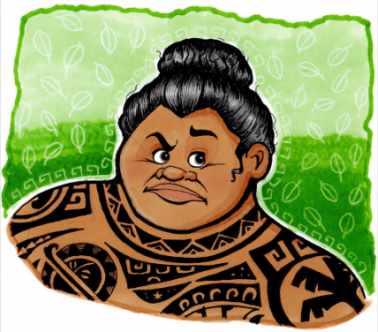 Maui was not submissive, neither meek or humble, nor patient, or full of love. That last point, about being willing to submit to God? That was missing too, since Maui thought the Ocean – what I think is a symbol of the Will of God, remember – was fickle, incomprehensible and crazy. As he put it, the Ocean was “kooky dukes”. Furthermore, Maui took credit for everything accomplished from the beginning of the world, totally forgetting that he absolutely could not have done it without the Fishhook (Jeremiah 17:5, 2 Nephi 4:34) . Like many LDS men do, Maui had allowed himself to entertain and then embrace the falsehood that he was the Fishhook. (Though our prophets have repeatedly taught against it, within LDS culture it is still very common to call men “the Priesthood”.) Maui also deeply feared the power which would have benefited him most, had he not offended it and viewed it as no sin: the Heart of Te Fiti.
Maui was not submissive, neither meek or humble, nor patient, or full of love. That last point, about being willing to submit to God? That was missing too, since Maui thought the Ocean – what I think is a symbol of the Will of God, remember – was fickle, incomprehensible and crazy. As he put it, the Ocean was “kooky dukes”. Furthermore, Maui took credit for everything accomplished from the beginning of the world, totally forgetting that he absolutely could not have done it without the Fishhook (Jeremiah 17:5, 2 Nephi 4:34) . Like many LDS men do, Maui had allowed himself to entertain and then embrace the falsehood that he was the Fishhook. (Though our prophets have repeatedly taught against it, within LDS culture it is still very common to call men “the Priesthood”.) Maui also deeply feared the power which would have benefited him most, had he not offended it and viewed it as no sin: the Heart of Te Fiti.
Can Maui be charming? Yes, of course he can. Cooperative? Yes, when he wants to be. Likeable? Very. Nevertheless, there is only one scene in the entire movie that I can think of, at least, – where Moana faces off with Te Ka – where Maui’s efforts are truly unselfish (Luke 18:2-5). Otherwise, everything is always about him, or at least what’s in it for him. A lyric from his song that goes, Look at that mean Mini Maui just tickity tappin’, sounds a whole lot more like, Look at me, me, me, me, me, me tickity tack! I wasn’t convinced at the end of the movie that Maui had really learned any lessons at all, let alone had a permanent change of heart. Why? Well, he sure seemed to bounce back to his old self-obsessed self, once he got back the fishhook. Therefore, I don’t like the unspoken message that is given, via his total absolution, that maybe one self-sacrificing heroic deed (triggered by a bit of guilt, maybe?) can erase many more self-serving, not-so-heroic ones. It’s almost like deathbed repentance, and I detest that concept. You would think that after 1,000 years, his tattoos would show individuals who are special to him, but, beyond his nemeses, Moana is THE FIRST person who is not just another nameless, faceless stick-figure forever singing all-praise to Maui in his tattoos.
Maui represents unrighteous dominion, first as a victim and then as a perpetrator. Both male and female individuals can exercise unrighteous dominion – it’s not just a male thing. Whether you call it abandonment or human sacrifice, Maui’s parents exercised an unrighteous dominion like that of Terah, the father of Abraham (Abraham 1:5-7, 2:5, Moses 7:33). I have no idea what their motivations, or idols, might have been. Maui was very plain about what his idol was: the praise of men (2 Nephi 26:9). Once she had recognized this, Moana was easily able to persuade Maui to do what was right, even if for the wrong reasons. He agreed to return the Heart of Te Fiti not because of godly sorrow for committing a grave offense, but to stroke his ego. Moana successfully persuaded Maui by appealing to his idol. Maui! Maui! Maui! He’s awesome!
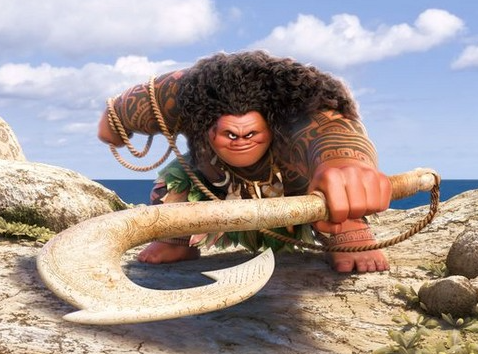
Many people reject [the celestial law] because it does not allow them to take advantage of other human beings and requires repentance from every sin (which repentance is to stop taking advantage of other human beings and to truly bless them instead). The weakness that prevents and destroys Zion is human selfishness. – Professor emeritus Chauncey C Riddle, quoted by D. Todd Christofferson, BYU speech, June 2010
Maui may also be another Disney effort at obsessing over, spreading and then making nonsensical another corrupted Savior-story. They did it with Hercules.They did it with Pinnochio, Brother Bear, Brave, the beautyless Beast, the deathless family in Tuck Everlasting and maybe even Tony and Tia from Escape to Witch Mountain. Across the world, there are myths and stories of a half-man half-god, with animal variations substituted for the deity half, like is apparent with the satyrs and centaurs in Fantasia. All of these are stories which I think are corruptions of the prophecies which have been given to the world since Adam. They are true prophecies of the coming of Jesus Christ, the Son of God. In the case of this particular movie, I would say that Moana is much more of a sincerely Christlike, self-sacrificing figure than Maui could ever be. It might even, perhaps just a repeat of the message intrinsic to the characters of Belle, Pocahontas, Mulan, Pollyanna, The Parent Trap twins, the women in Freaky Friday or even the females in Watcher in the Woods: that if the men won’t or can’t do it, well then, the women can and will. Nevertheless, I am glad that Disney “dropped the ball” and did not make Maui the protagonist, when they could have.
Contrary to the general public consensus that I have been reading online, there may actually have been a love between Moana and Maui in this film – or at least the beginnings of one – and that is just fine with me and my husband. That love is not called romance. It’s called friendship. Wow! Revolutionary thought! As I told Jeff in the kitchen the night after we first watched Moana, despite the incredible event he witnessed between Moana and Te Fiti, Maui has not yet recognized that Moana is his equal,; that she is basically a “demigoddess” just as he is. Maybe he will, once he decides it isn’t good to be alone; once he realizes that Woman, in covenant partnership with Man, carries the power of creation he was seeking to give mankind all along.” (Maybe his conscience, Mini Maui, will learn that first from Mini Moana in Tattooland, haha.)
The world does not recognize the fraternal love between Moana and Maui as the seed of, perhaps, a future permanent union, because their relationship building was portrayed without fanfare or silly notions of romance. Yes, they actually dialogue, and extensively! And wonder of wonders, they develop feelings without delving into sex! In other words, real love is happening realistically. Wow, what a concept! By spending time with each other in various settings and serving each other under various stressors, they actually got to know each other and began to care for each other. Ahhhh! Sweet nectar! For once, Disney did not play their worn-out and predictable plot twist of a love-at-first-sight romance based on physical beauty or shiny princess apparel.
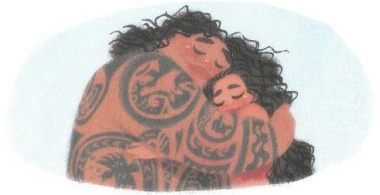 The only other “meeting of equal minds” I can think of in a Disney film is that of the relationship between Shang and Mulan. With Moana, Disney followed the same pattern: starting out somewhat adversarial, developing into friendship, morphing into healthy respect… In Mulan’s case, this all finally blossomed into love. Who knows what will, might or could happen between Maui and Mulan in some fictional future? What we do know is that these two share no foundation of pain from too much, too quick, too far. It’s like what was well-said by Lex de Azevedo in some lyrics he wrote, “If you want me, then want me to happy when tomorrow comes… If you love me, then [give me a relationship] with only good memories and a good conscience.” With a relationship this pure, how wonderful for these two characters that whether love blossoms or not, all is well.
The only other “meeting of equal minds” I can think of in a Disney film is that of the relationship between Shang and Mulan. With Moana, Disney followed the same pattern: starting out somewhat adversarial, developing into friendship, morphing into healthy respect… In Mulan’s case, this all finally blossomed into love. Who knows what will, might or could happen between Maui and Mulan in some fictional future? What we do know is that these two share no foundation of pain from too much, too quick, too far. It’s like what was well-said by Lex de Azevedo in some lyrics he wrote, “If you want me, then want me to happy when tomorrow comes… If you love me, then [give me a relationship] with only good memories and a good conscience.” With a relationship this pure, how wonderful for these two characters that whether love blossoms or not, all is well.
I will admit that for me, in the symbol of Maui, gender does come into play with one point: the male vs female power struggle that has zigzagged it’s threads of tug o’ war across our human history. Maui represents patronizing patriarchy, in opposition to the youthful, idealistic matriarchy of Moana AND right in the face of the omnipotence of God. My husband and some of my kids are quick to point out that according to the narrative, Maui is already over 1000 years old. But I’m not seeing or feeling a father-daughter vibe here at all. I guess this is a blind spot for me. I honestly don’t see him as much older than Moana, or even, really, as among the immortals, perhaps because of his incredible immaturity. How can he be a god or even a demigod when he so often acts like such a jerk? Moana seems more mature in comparison. Anyway, for more of my thoughts on patriarchy and priesthood, please read the next section about the Fishhook… if you dare to even listen to and seriously consider the thoughts of a girl.
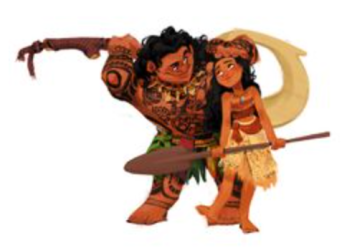
THE FISH HOOK
This object’s symbolism was clearly provided by Disney: power given to one man by gods. So, extrapolate that into LDS thinking, and the fish hook represents divine power given to men by God. In other words, the fish hook represents the Priesthood. Maui’s attitude was so typical: I am my hook. Look at all the great things I have done, forgetting that without the fish hook he could have done nothing. One thousand years marooned on an island without it (Great Apostasy much?) seemed to teach that lesson to his mouth, but not to his heart. Maui’s tattoo stories of all “his” great exploits remind me of the history of the miracles wrought by the power of the Priesthood of God which we have available to us in sacred writ. See what Noah did? Yeah, I did that. See what Jesus did? Yeah, I did that too.
It makes the song he sings, You’re Welcome, a comic irony. You want to laugh and cry at the same time because he’s got the idea… sort of. I am sure that God delights to bless his children, but remember, it’s GOD who’s doing that, whether by his own Providence or through the instrumentality of man, it’s still GOD saying “you’re welcome”. The role of men is to preside, provide and protect. They are supposed to use the Priesthood to serve others and not themselves. Instead of heaping praise and honor upon themselves, all of that stuff is supposed to go to God, the one responsible for the example and power by which he does all those good things.
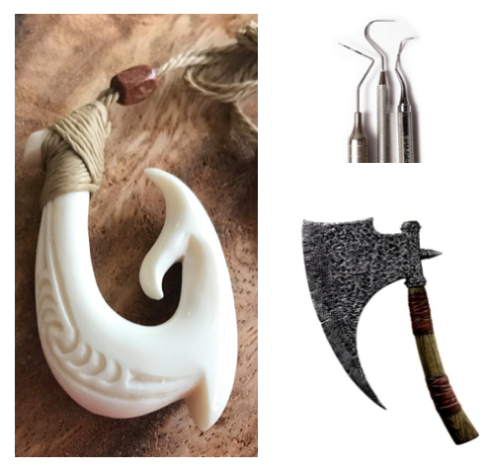
The symbol of the fish hook also shows CLEARLY how EASILY power and authority can be ABUSED when wielded without care. It can cause great harm – like chopping off hands. Did you know that the word, manifest, means to show your hand? (See 1 John 4:9, and 3:10). Unwisely wielding the power of the Priesthood can deeply wound the heart. Think of how Maui used it to gouge out the Heart of Te Fiti (Jacob 2:35). Reproving betimes with sharpness (with the word sharpness, think “exactness”, as in dental probe) instead becomes “passionately using a headmans axe” (D&C 121:43).

Acts 9:5, D&C 121:38 versus Genesis 32:24, Enos 1:2, Alma 8:10,
In thinking about this symbol and the broken concept areas in the You’re Welcome song, I decided to make the attempt to correct it. I fixed what I thought was broken by changing the lyrics to read as if our God, the actual Creator of heaven and earth, were singing to His children. After all, the Fish Hook is HIS. So here it is:
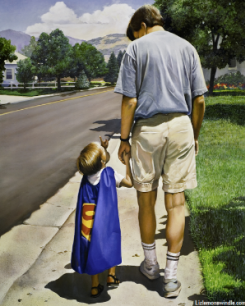 I see what’s happening, yeah
I see what’s happening, yeah
You’ve looked around your world and you see
How much you’re loved!
It’s adorable!
Well, it’s nice to see you’ve realized that I care
You’ve opened your eyes and begun
Yes, it’s really me, it’s Father, breathe it in!
I know it’s a lot: the hair, the bod!
When you’re staring at your Father; God
 What can I say except you’re welcome
What can I say except you’re welcome
For the tides, the sun, the sky
Hey, it’s okay, it’s okay
You’re welcome
You’re my work and my joy, so I’m your guy
Hey!
Who has two hands that set up the sky
When you were waddling yay high
This guy!
When the nights got cold
Who gave you fire to melt the snow
You’re lookin’ at him, yo
Oh, also I light up the sun
You’re welcome!
To stretch the days and bring you fun
Also I command the breeze
You’re welcome!
To fill your sails and shake your trees
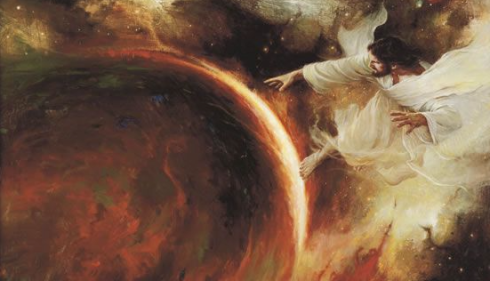
So what can I say except you’re welcome
For the islands I placed in the sea
I hear you pray, makes my day
You’re welcome!
Ha, it makes me so happy that you see!
You’re welcome!
You’re welcome!
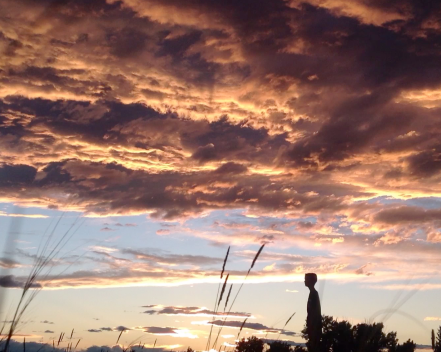
Well, come to think of it
Kid, honestly I can go on and on
I can explain every natural phenomenon
The tide, the grass, the ground, oh
That was all me setting’ up your home-ground
I took a seed
And it quickened. That’s what
Sprouted a tree, now you got coconuts
What’s the lesson
What is the take-away
Life brings forth life in it’s image, that’s what I say
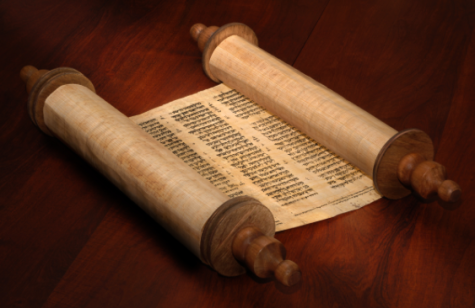
And the scriptures writ’ here on lamb’s skin
Is a map of the victories I win
Look where I’ve been
I make everything happen
Now look at you, mini-me, tippity-tappin’ !
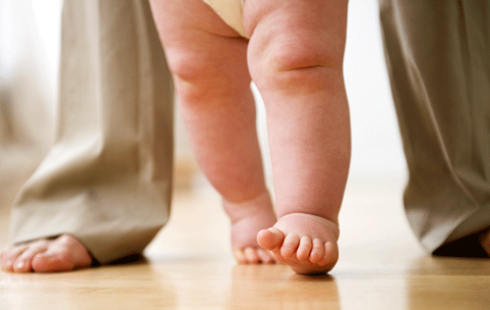
Well, anyway let me say you’re welcome
For the wonderful world you know
Hey, it’s okay, it’s okay
You’re welcome!
Well, come to think of it, you’ve gotta go
Hey, it’s your Day to say you’re welcome
‘Cause you’re gonna need that boat
You’re sailing this way, to me
You’re welcome!
‘Cause in me you can do anything! So, float!
You’re welcome!
You’re welcome!
And thank you!
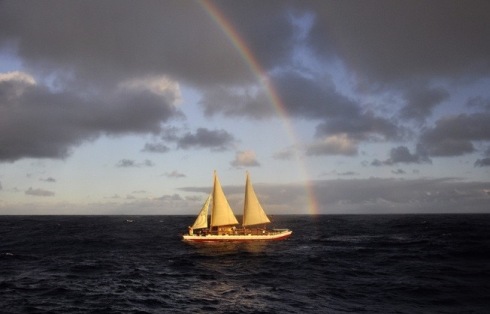
MAUI’S ANIMAL FORMS
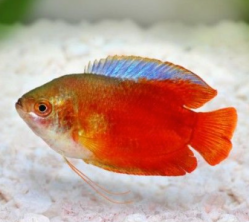
LITTLE FISH: Positive symbol
The little fish symbol appears at the very, very beginning. This is the very first form that Maui takes after he has made the dramatic seizure of the hook before the very eyes of Tamatoa. He wanted the grandeur, the most sweepingly powerful and visible form of Gods power, as personified in the golden eagle but was quite dismayed to become “just” a little fish instead. I think this inadvertent form (for him) was a big hint to Maui (from the fish hook) that Maui initially missed (D&C 63:9, Psalm 8:4-8). Watch for where he actually chooses to use the form of the little fish again. I think it’s important.(Mark 6:38, Luke 5:6, Hosea 4:3, Matthew 17:27, 3 Nephi 14:10, Luke 24:42) And hello, ichthys, the symbol used by early Christians? Like the fish, the other huge symbol of Christianity, the willing and obedient sheep, is scoffed at and mocked by Tamatoa and his followers in the World. Baa-baa, buh-bye to you seemingly mindless sheeple, right? (Alma 37:6, D&C 65:2) Summary: Initially rejected but later accepted by Maui (Matthew 21:28-31).
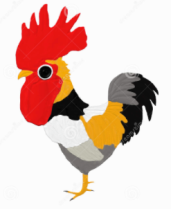
2.) ROOSTER: Positive symbol
After his humbling struggle with Tamatoa, having only achieved victory because of Moana’s help, Maui realizes he has accidentally turned into a rooster. He is incensed, and instantly changes form. This says a lot about what he thinks of HeiHei and therefore gives insight into the character of Maui himself. He totally misses the message that perhaps he should consider being more faithful, like HeiHei, if he would like to use the fishhook as he desires. In scripture, the rooster, or cock, is associated with dawning of a new day, or the ministry of prophets. (Matthew 26:34, JSH 1:47). Summary: Maui accidentally takes the form of the rooster once, instantly rejects it and never returns to it (Mark 4:4, Moses 5:13, S.W. Kimball’s talk: Peter, My Brother .)
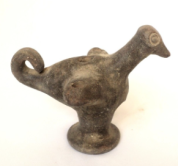
Clay oil lamp, India
When I searched DuckDuckGo for the biblical symbolism of the rooster, I found a page with an astonishing mass of information. Here are the highlights. “In Christian tradition, the rooster symbolizes a sinner’s acceptance of divine pardon through Jesus Christ… [Artwork portraying roosters adorned the tombs of early Christians] A 3rd-century fresco of Jesus Christ was found in the Catacomb of Callixtus. It portrays Jesus as the Good Shepherd and there is a rooster at his feet… The Hebrew word gever means both “man” and “rooster” so punishment of the rooster can be substituted for that of a person who deserves punishment, [such as in the practice of kapparot, observed] by some Jews shortly before Yom Kippur… The rooster is an archaic symbol…associated with the sun… the symbol of the Creator, because it crows before dawn…The association of the rooster with light may explain why some clay oil lamps had rooster images… The golden rooster is said to be a symbol of Jesus Christ who breaks the power of the darkness, brings forgiveness of sins, and announces a new day by the power of His resurrection.”
The rooster may also represent the protection of God. I would like to add the caveat that this protection takes effect when we accept it and allow him to fulfill that role as demonstrated by our own actions to obey His laws (1 Corinthians 10:3, Mosiah 2:24, Helaman 4:24, Psalm 84:11). The factory farms used nowadays to raise chickens for meat and eggs are a far cry from what used to be. Of all the animals being abused today, I pity the chickens most. Hens are separated from offspring while denied protection of the rooster. Motherless baby chicks are incubated, hatched, mistreated, manhandled, injured, and – especially if male – thrown away alive. It’s slavery, and it’s totally unnatural. I once visited an organic farm that had free-range chickens. There was a polygynous little troop of about 5 hens and a rooster. Wow. If you’ve never been attacked, (or had to protect a small, unknowing child from risk of being attacked) then you might not understand. It is sobering to face down a magnificent, multi-colored, free-range rooster with spurs intact, who, for the love of his harem, is not about to let you pass. They are scarier than some guard dogs, especially if provoked enough that they’ll actually use their wings and go for your face with their talons and spurs outstretched. A congruent form of protection can also be seen in “gentler sex” of the beings we call chickens. In holy writ, the Master honors the hen, using her as a symbol of his own Self (Matthew 23:37, D&C 29:2).
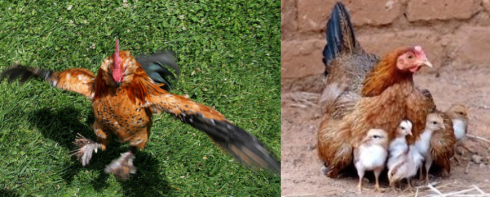
According Wikipedia and the writer of the webpage I cited earlier, there is a book called De Ordine, in which I think Augustine, Bishop of Hippo, somewhat shockingly misdescribes the rooster as follows: “in every motion of these animals unendowed with reason there was nothing ungraceful since, of course, another higher reason was guiding everything they did.” What?! Jesus take the wheel, take it from my hands! How ridiculous and untrue and stupid! All animals are intelligences clothed with physical bodies, but only man has been given the full use of his agency. Therefore, any rooster, including HeiHei, if accurately depicted and perceived, does have reasoning powers. However limited, HeiHei , in cooperation with the Ocean, Moana and Maui, used his capabilities fully to obey and fulfill his mission. That’s a lesson which, if Maui learned, might finally make him better than a chicken.
 Side-note: That last sentence is an homage to my father. When he was a young adult, he was questioning, for himself, the actual existence of God. He was attending university, training to be a chemist. One evening, he and the night time janitor got into a conversation about these things. When my father voiced his conclusion that perhaps there really was not a God, the old janitor said ,”Well then, I guess that makes you no better than a chicken.” This simple comment changed my father’s life. (If there was no God, in whose image he himself was not created, what was the point of his existence?) Dad eventually found the Church of Jesus Christ of Latter-day Saints. So, I thank you, old janitor man.
Side-note: That last sentence is an homage to my father. When he was a young adult, he was questioning, for himself, the actual existence of God. He was attending university, training to be a chemist. One evening, he and the night time janitor got into a conversation about these things. When my father voiced his conclusion that perhaps there really was not a God, the old janitor said ,”Well then, I guess that makes you no better than a chicken.” This simple comment changed my father’s life. (If there was no God, in whose image he himself was not created, what was the point of his existence?) Dad eventually found the Church of Jesus Christ of Latter-day Saints. So, I thank you, old janitor man.
My testimony: I did not know any of these things about the symbolism of the rooster until all I’ve described in this post about Moana so far. I have actually known various individuals who love this poultry theme so much that they use it in decorating their houses, especially their kitchens. Roosters all over the place were not my taste, and became much more so when later experience came to make this symbol a constant reminder of someone I had hurt; to whom I could not make amends. Fast forward to a few years ago when I was making a nativity creche for a 12 Days of Christmas secret gift drop-off for some friends. Despite making a flock of sheep, including a black one, and a Good Shepherd and Undershepherd to watch over them, I kept feeling like there were not enough characters. I felt impressed to add more women. Thinking of Little Bo Peep, I started work on creating a shepherdess (as a wife for a shepherd), but then remembered how Bo Peep lost her sheep. I decided my woman needed a symbol of her own, and discovering a button I had that looked like a rooster, I went with that. Manger, stable, barnyard, rooster… right? But I never ended up giving this first figure to my friends because I made her with red hair. She looked so much like Nicole, another sister in our local LDS branch, that I went back to the drawing board and made a blonde wife to resemble Donni, the mother of our target family. When I had created her as shepherdess in terms of her primary role as wife and mother, everything just flowed from there. I ended up adding figures of all their children so that these visitors to the manger matched the actual family we knew, right on down to the baby.
own, and discovering a button I had that looked like a rooster, I went with that. Manger, stable, barnyard, rooster… right? But I never ended up giving this first figure to my friends because I made her with red hair. She looked so much like Nicole, another sister in our local LDS branch, that I went back to the drawing board and made a blonde wife to resemble Donni, the mother of our target family. When I had created her as shepherdess in terms of her primary role as wife and mother, everything just flowed from there. I ended up adding figures of all their children so that these visitors to the manger matched the actual family we knew, right on down to the baby.
Christmas came and went, leaving my “Chicken Woman” quite forlorn, standing alone there on my work table. I could have, maybe should have thrown her away, but I just could not bring myself to do it. It had something to do with the expression on her face and the way she was holding that rooster. I contemplated giving the figure to Nicole, but I found I could not do that either. How would I explain it to her? And anyway, in the interim the Chicken Woman had somehow become MINE. Maybe… maybe even me. (From childhood, I have admired the beautiful chestnut shade of dark auburn hair.I even saw my oldest daughter in a dream before she was born, only her hair was red in it.)
When we understand more than we know with our minds, when we understand with our hearts, then we know that the Spirit of the Lord is working upon us. – Harold B Lee
Could it be that maybe Heavenly Father was trying to teach me a lesson, in this little woman I had sculpted? Could she, so lovingly clasping a rooster, dare to approach the berth of her tender infant Lord and King? To tell him thank you? Was she now clean, and worthy enough to be included with the others as a partaker in His joy, instead of forever feeling like the Little Matchstick Girl, face pressed up against the glass (Matthew 9:21, Matthew 8:3)? The crowning touch to this story is that the day I was finally able to receive the temple endowment is the same date as my father’s baptism day; and the same day the prophet Joseph Smith was born; and winter solstice, the same day when light begins to return to the world. O Ye of little chicks (D&C 10:65-67)! As I write this, I am look back on this nativity experience, combined with the rooster symbolism and wonder at what I knew yet did not know. God was trying to teach me something important, and I think maybe now, as I write this, it has finally gotten through: The dark night is over. While there may still be mists of darkness and storms may still arise, the sun has still risen above the horizon (1 Nephi 8:7-8, Isaiah 60:1-2, 1 Nephi 8:23-24, 2 Peter 1:19). The dawning of the day is here, and the return of Light cannot be stopped. It is breaking from the East and High Noon will be here soon. (See an address “The Morning Breaks, The Shadows Flee” given by Elder Bruce R. McConkie, April 1972)
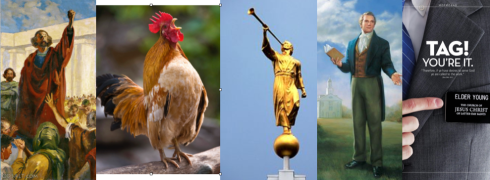
The morning breaks, the shadows flee; Lo, Zion’s standard is unfurled!
The dawning of a brighter day!
The dawning of a brighter day majestic rises on the world!
Angels from heav’n and truth from earth have met, and both have record borne;
Thus Zion’s light is bursting forth!
Thus Zion’s light is bursting forth to bring her ransomed children home.
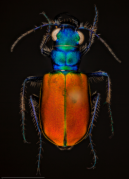
BUG: Postiive/Negative Symbol
Levitical dietary law allowed certain insects to be eaten as food for man, and forbade the use of others. Insects are also described as having the power, if allowed, to pester the land and eat man’s grain. (Leviticus 11:21-23, Mosiah 12:6.)
Summary: Used by Maui for sneaky, trickster activities. He only likes it when it gives him the upper hand.
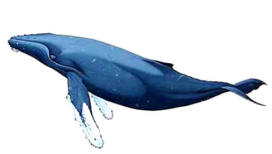
WHALE: Positive/Negative symbol
Created by God and described as good. God used the whale to humble Jonah. However large a wicked people may become (large as a whale), God can still destroy them. Without the protection of the Lord, whales described as being a hazard to those traveling in boats. (Ether 2:24, Genesis 1:21, Abraham 4:21 — Ezekiel 32:2-4, Ether 6:10, Matthew 12:40)
Summary: Used by Maui to tease both Moana and Te Ka, much to his delight.

REINDEER: Not Applicable
I didn’t study this, because it seemed so out of place. It appears only once, Disney animators making no further character development. All of this makes sense once you see the bonus footage, revealing that the Reindeer was an “easter egg”, what the industry calls an allusion to another movie. In this case, the homage was to Frozen. Yuck.
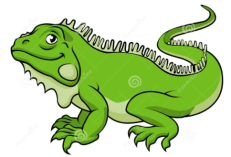
IGUANA LIZARD: Negative or Not Applicable symbol
An unclean animal per Levitical law (Leviticus 11:29-30)
Summary: Used by Maui to playfully tease and taunt, first with HeiHei, then with TeKa.
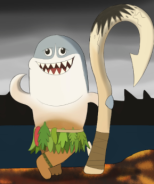
SHARK / SHARK HEAD / SHARK HINDQUARTERS: Negative-to-positive symbol
God can protect us from monsters of the sea (Ether 6:10), even if they are us, ourselves. Maui doesn’t much seem to like being a shark head. It is embarrassing to him. Seeing him in this form makes Moana laugh at Maui. However, he saves the Heart of Te Fiti , by swallowing it, first as a shark and then as a little fish. I think this hints at HeiHei’s stalwartness (he must partake, just like HeiHei). I think this points at the miracles which sometimes follow the seemingly worthless and simple faithful little Christian fish. I think this order points at the process of true conversion (Mosiah 3:19, Daniel 10:12, D&C 5:24)
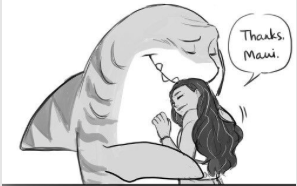
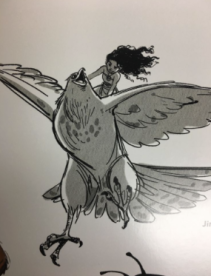
GOLDEN EAGLE: Positive Symbol
This is Maui’s favorite animal, which I find very interesting. It is the first animal he wants to be when he gets the fish hook back. It is the animal whose form he takes when he repents, and returns to help Moana wrestle with Te Ka. The Maui golden eagle (or hawk?) flies over Moana’s family as they navigate the seas, near the movie’s end. I think it represents Maui when he is using his authority appropriately, and with power. I think the one time he misused it is a huge reason why Te Ka appeared, for God will not be mocked.
Furthermore, the golden eagle is a much nobler bird than the bald eagle. (I have another post on this blog about how craptastic the bald eagle actually is.) From my personal studies, I have come to believe the golden eagle is also a favorite symbol of Deity, for it is often used in scripture to represent God himself, and his power (i.e. wings). It is a magnificent symbol of the power of God to lift us to the heights, blessing us for righteousness, or swiftly inflict the consequences we have earned by our own bad choices.
POSITIVE SYMBOL (if you are on God’s side)
Parable of the Eagles and the Cedar Trees – Ezekiel 17
Parable of the Eagles JST, Luke 17:36–40, JST Matt 1:27
See also Isaiah 40:31, Deuteronomy 32:11-12, Exodus 19:4-5, D&C 124:18, Revelation 12:14
NEGATIVE SYMBOL (to the deliberately wicked and knowingly rebellious)
Proverbs 23:4-5, Jeremiah 49:16, Proverbs 30:17, Lamentations 4:19, Hosea 8:1, Obadiah 1:4, Jeremiah 48:40, Micah 1:16, Leviticus 11:13, Deuteronomy 28:49
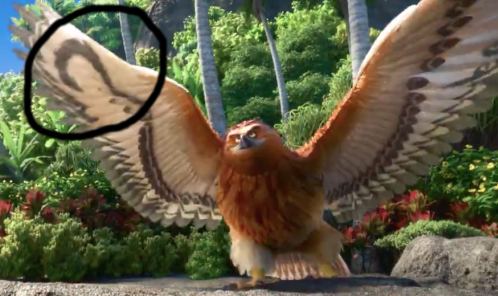
LINKS:
Moana – A Parable of Christ – Part 1
Moana – A Parable of Christ – Part 2
Moana – A Parable of Christ – Part 3
Moana – A Parable of Christ – Part 4
Moana – A Parable of Christ – Part 5 NEXT
Moana – A Parable of Christ – Part 6
Moana – A Parable of Christ – Part 7
Moana – A Parable of Christ – Part 8
NOTICE TO ARTISTS: I draw with words, but most people still want to see pictures, and I do not own any images. Wherever possible, I have tried to turned to fan art and merchant art, rather than Disney, for illustrations. If you would like an image removed, please contact me. I will take your art down immediately.
Note: This essay may contain copyrighted material the use of which has not always been specifically authorized by the copyright owner. This presentation is making such material available in an effort to advance understanding of religious issues. This essay presentation is a Creative Commons work – available for free in the public domain – of criticism, commentary, research and nonprofit education and thus constitutes a ‘Fair Use’ of any such copyrighted material as provided in the United States Copyright Act of 1976, 17 U.S.C. § 107.

8 comments
Comments feed for this article
March 31, 2017 at 10:18 am
Moana – A Parable of Christ – Part 1 | OilStories: Adventures In Living
[…] Moana – A Parable of Christ – Part 2 Moana – A Parable of Christ – Part 3 Moana – A Parable of Christ – Part 4 Moana – A Parable of Christ – Part 5 Moana – A Parable of Christ – Part […]
March 31, 2017 at 10:24 am
Moana – A Parable of Christ – Part 2 | OilStories: Adventures In Living
[…] 1 Moana – A Parable of Christ – Part 2 Moana – A Parable of Christ – Part 3 Moana – A Parable of Christ – Part 4 Moana – A Parable of Christ – Part 5 Moana – A Parable of Christ – Part […]
March 31, 2017 at 10:26 am
Moana – A Parable of Christ – Part 3 | OilStories: Adventures In Living
[…] 1 Moana – A Parable of Christ – Part 2 Moana – A Parable of Christ – Part 3 Moana – A Parable of Christ – Part 4 Moana – A Parable of Christ – Part 5 Moana – A Parable of Christ – Part […]
March 31, 2017 at 10:29 am
Moana – A Parable of Christ – Part 5 | OilStories: Adventures In Living
[…] 1 Moana – A Parable of Christ – Part 2 Moana – A Parable of Christ – Part 3 Moana – A Parable of Christ – Part 4 Moana – A Parable of Christ – Part 5 Moana – A Parable of Christ – Part […]
March 31, 2017 at 8:02 pm
Moana – A Parable of Christ – Part 6 | OilStories: Adventures In Living
[…] 1 Moana – A Parable of Christ – Part 2 Moana – A Parable of Christ – Part 3 Moana – A Parable of Christ – Part 4 Moana – A Parable of Christ – Part 5 Moana – A Parable of Christ – Part […]
August 22, 2018 at 9:38 am
S T | OilStories: Adventures In Living
[…] THAN HE ALREADY HAS] In this way you will have strength against the enemy, who would otherwise buffet you and say, “Here is your wickedness made manifest,” and would overcome you and destroy all […]
January 23, 2019 at 12:29 am
Moana – A Parable of Christ, Part 7 | OilStories: Adventures In Living
[…] 1 Moana – A Parable of Christ – Part 2 Moana – A Parable of Christ – Part 3 Moana – A Parable of Christ – Part 4 Moana – A Parable of Christ – Part 5 Moana – A Parable of Christ – Part 6 […]
January 24, 2019 at 5:14 am
Moana – A Parable of Christ – Part 8 | OilStories: Adventures In Living
[…] my thoughts in Part Four on Maui representing the natural man, an enemy to God, I was surprised to read this lyric. But it […]